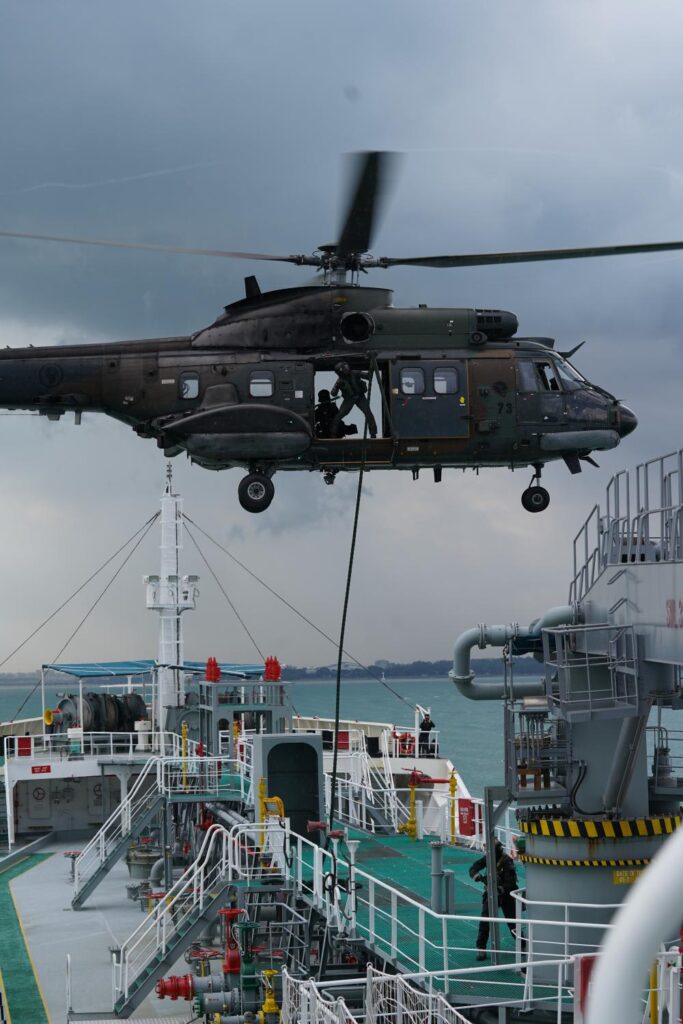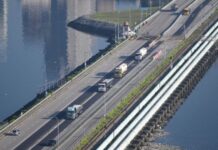Singapore: In the waters near the southeastern tip of Singapore, “trouble” is brewing.
The Singapore Maritime Crisis Center (SMCC) is composed of different agencies such as the Republic of Singapore Navy (RSN) and the Police Coast Guard (PCG). It is responsible for detecting and responding to maritime security threats and marking a chemical tanker heading for Singapore to show Called abnormal behavior.
SMCC observed that this particular tanker had disappeared from conventional shipping channels earlier, but then reappeared, raising the suspicion that it might be hijacked.
Even more worrying is that the Maritime and Port Authority (MPA), another SMCC agency, detected explosive cargo in the tanker’s manifest.
RSN and PCG sent a littoral mission ship and interceptor boat to escort the tanker. At a nearby base, elite operators from the Special Operations Task Force (SOTF) are on standby.
Suspicious oil tankers were escorted to specific anchorages far away from the mainland for inspection, while marine reserves diverted traffic to different waterways. The RSN boarding team climbed onto the tanker to determine intent.
Instead, the crew of the tanker pulled out their guns, and an exchange of fire broke out. SMCC declared the ship a hostile ship, and the special operations task force soldiers on the speedboat and the Republic of Singapore Air Force Super Puma helicopter were released.
Before the threat was lifted, the soldiers tied ropes to the tanker. Then there was a fire, probably due to gunfire on the ship. The Singapore Civil Defence Force activated a special fire boat to extinguish the fire.
Finally, the MPA tugboat towed the tanker away, avoiding a potentially devastating crisis on Singaporean soil.

Intelligence collected by SMCC shows that terrorists intend to crash the tanker into a key facility on Jurong Island as part of a larger strategy to attack US allies in the region.
This scenario is part of the peak exercise in 2021, which was held from Monday (November 8) to Friday to test inter-agency coordination to eliminate threats and block sea lanes in severe maritime security situations.
Senior Minister and Coordinating Minister for National Security Teo Chee Hean visited RSS Singapore-Changi Naval Base on Friday to observe the exercise and listen to the progress of the SMCC.
The exercise is a biennial event, because the threat of terrorism to Singapore is still high, and attacks from the sea cannot be ruled out.
IMPROVED SENSE-MAKING SYSTEM
This is why SMCC was established in 2011 and is usually the brain behind maritime security operations, such as the role played during the Highcrest exercise, hoping to better complete its work.
The Ministry of Defence (MINDEF) stated at a press conference on Friday that the center is developing a next-generation perception system to improve its ability to “as soon as possible and as far away as possible” from Singapore’s maritime security threats.
The system will be fully put into use in the middle of next year.
“The system uses real-time links to the national maritime safety agency database and information collected from shipping industry stakeholders to detect and flag ships with abnormal behavior in real time,” MINDEF said.
“With the evolution of threat scenarios, ship data has been continuously improved to discover potential maritime security threats, with almost no obvious signs.”
These threat assessments are then shared with national maritime safety agencies so that they can decide on related operational responses.
SMCC has done similar things by integrating information from national intelligence agencies, think tanks, and commercial maritime stakeholders, so as to be able to coordinate and multi-level responses to identified threats.
For example, the center coordinates maritime security operations during high-profile events held near coastal areas, such as the National Day military parade and the 2018 Trump-Kim summit, when the two leaders met in Sentosa.
In 2019, SMCC’s meaning building system successfully marked a ship carrying a crew member who posted radical religious messages on social media.
The security forces board the ship to ensure that the crew is not malicious, and the immigration and checkpoint bureau prohibits the crew from disembarking.
QUICKER DETECTION OF SUSPICIOUS SHIPS
The next-generation perception system will provide a more comprehensive, automated and real-time threat assessment to improve situational awareness and decision-making capabilities.
It automatically ingests and integrates maritime information from more sources, including proprietary entire government systems, commercial platforms, and publicly available ship data.
These sources include surveillance cameras belonging to Home Team organizations, and commercial multinational maritime information sharing platforms.
The system then uses data analysis and a technique called entity resolution to match the data with the correct ship, and then uses it to detect signs of suspicion.
Some signs involve ships that have widely deviated from the course, or those crew members who fail to submit the required documents before entering Singapore waters.
“Some sources did not perform fact-checking on the data, including the names or numbers entered,” said Mr. Tan Yangzhi, project manager of the National Defense Science and Technology Agency, which has jointly developed the system with DSO National Laboratory.
“But the entity resolution algorithm allows us to match (even if the data) contains misspellings or missing numbers.”

Once a ship is marked in the system, its interface (showing the outline of Singapore surrounded by thousands of points representing the ship) will display a pop-up window prompting SMCC personnel to look at the ship more carefully.
They can check the cause of the trigger by looking at the different data sets on board. This information is shared with different maritime safety agencies who see the same picture, and they can then decide on the appropriate response.
Colonel Desmond Low, head of the SMCC National Maritime Perception Team (COL), said that this approach will reduce the time required for a single ship to conduct a threat assessment from a few hours to a few minutes.
He said that in the past, SMCC operators had to manually insert some data into the old system, and due to the large amount of data, some analysis also needed to be done manually in batches.
EVOLVING THREATS AND TECHNOLOGY
Mr. Teo told reporters on Friday that the next-generation system uses data analysis to “try to detect possible threat patterns earlier.”
“So when they approach our coast, you can be prepared to investigate them further and make sure they don’t present themselves as a threat,” he said.
Mr. Teo pointed out that Singapore is located on one of the busiest waterways in the world, with many ships calling at Singapore’s ports and “close to our land.”
He added: “Therefore, we must be prepared for different types of threats, and they are constantly evolving.”
For example, chemical ships can act as floating time bombs, medium passenger ships can transport terrorists, and smaller ships can be used to hit targets.
“In order to maintain a leading position in the ever-changing threat environment, the system will continue to be upgraded to integrate more data sources and take advantage of the latest developments in data analysis,” MINDEF said.

COL Low stated that the next-generation system was first developed at the end of 2016, and SMCC used its earlier version in 2017.
He said that it has been continuously improving over the years and is currently in the final stages of integration and testing.
“Test the different incoming data streams, analysis tools-to make sure we get the correct answers-and some built-in security systems,” he added.
“Because this will be used with our maritime security partners, one of our main concerns is also cyber security… and protecting important data.”






